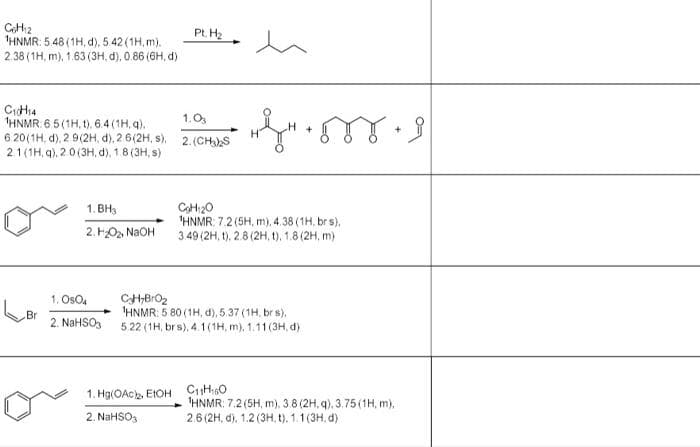C6H₁2 HNMR: 5.48 (1H, d), 5.42 (1H, m). 2.38 (1H, m), 1.63 (3H, d), 0.86 (6H, d) C₁0H14 ¹HNMR: 6 5 (1H, t). 6.4 (1H, q). 6 20(1H, d), 29(2H, d), 26(2H, s). 2.1 (1H, q), 2.0 (3H, d), 1.8 (3H, s) Br 1.BH 2. H₂O₂, NaOH 1.0504 2. NaHSO Pt. H₂ 1.0₂ 2. (CH₂) S J.sr.s CH₁₂0 ¹HNMR 7.2 (5H, m), 4.38 (1H, brs), 3.49 (2H, t), 2.8 (2H, t), 1.8 (2H, m) C₂HBrO₂ HNMR: 5.80 (1H, d), 5.37 (1H, brs), 5.22 (1H, brs), 4.1(1H, m), 1.11 (3H. d) 1.Hg(OAch, EtOH CHO 2. NaHSO3 ¹HNMR: 7.2 (5H, m), 3.8 (2H., q). 3.75 (1H, m), 2.6 (2H, d), 1.2 (3H, t). 1.1 (3H. d)
C6H₁2 HNMR: 5.48 (1H, d), 5.42 (1H, m). 2.38 (1H, m), 1.63 (3H, d), 0.86 (6H, d) C₁0H14 ¹HNMR: 6 5 (1H, t). 6.4 (1H, q). 6 20(1H, d), 29(2H, d), 26(2H, s). 2.1 (1H, q), 2.0 (3H, d), 1.8 (3H, s) Br 1.BH 2. H₂O₂, NaOH 1.0504 2. NaHSO Pt. H₂ 1.0₂ 2. (CH₂) S J.sr.s CH₁₂0 ¹HNMR 7.2 (5H, m), 4.38 (1H, brs), 3.49 (2H, t), 2.8 (2H, t), 1.8 (2H, m) C₂HBrO₂ HNMR: 5.80 (1H, d), 5.37 (1H, brs), 5.22 (1H, brs), 4.1(1H, m), 1.11 (3H. d) 1.Hg(OAch, EtOH CHO 2. NaHSO3 ¹HNMR: 7.2 (5H, m), 3.8 (2H., q). 3.75 (1H, m), 2.6 (2H, d), 1.2 (3H, t). 1.1 (3H. d)
Chemistry
10th Edition
ISBN:9781305957404
Author:Steven S. Zumdahl, Susan A. Zumdahl, Donald J. DeCoste
Publisher:Steven S. Zumdahl, Susan A. Zumdahl, Donald J. DeCoste
Chapter1: Chemical Foundations
Section: Chapter Questions
Problem 1RQ: Define and explain the differences between the following terms. a. law and theory b. theory and...
Related questions
Question
complete the reactions. thank you

Transcribed Image Text:C6H₁2
HNMR: 5.48 (1H, d), 5.42 (1H, m).
2.38 (1H, m), 1.63 (3H, d), 0.86 (6H, d)
C₁0H14
¹HNMR: 6 5 (1H, t). 6.4 (1H, q).
620(1H, d), 29(2H, d), 26(2H, s).
2:1 (1H, q), 2.0 (3H, d), 1.8 (3H, s)
Br
1.BH₂
2. H₂O₂ NaOH
1.0504
2. NaHSO3
Pt. H₂
1. Hg(OAc), EtOH
2. NaHSO3
1.0₂
2.(CH₂)₂S
hrſ.
+
CH120
HNMR: 7.2 (5H, m), 4.38 (1H, brs),
3.49 (2H, t), 2.8 (2H, t), 1.8 (2H, m)
C₂HBrO₂
HNMR: 5.80 (1H, d), 5.37 (1H, brs),
5.22 (1H, brs), 4.1(1H, m). 1.11 (3H, d)
C11H150
¹HNMR: 7.2 (5H, m), 3.8 (2H, q), 3.75 (1H, m),
2.6 (2H, d), 1.2 (3H, t). 1.1 (3H, d)
Expert Solution
This question has been solved!
Explore an expertly crafted, step-by-step solution for a thorough understanding of key concepts.
Step by step
Solved in 7 steps with 7 images

Knowledge Booster
Learn more about
Need a deep-dive on the concept behind this application? Look no further. Learn more about this topic, chemistry and related others by exploring similar questions and additional content below.Recommended textbooks for you

Chemistry
Chemistry
ISBN:
9781305957404
Author:
Steven S. Zumdahl, Susan A. Zumdahl, Donald J. DeCoste
Publisher:
Cengage Learning

Chemistry
Chemistry
ISBN:
9781259911156
Author:
Raymond Chang Dr., Jason Overby Professor
Publisher:
McGraw-Hill Education

Principles of Instrumental Analysis
Chemistry
ISBN:
9781305577213
Author:
Douglas A. Skoog, F. James Holler, Stanley R. Crouch
Publisher:
Cengage Learning

Chemistry
Chemistry
ISBN:
9781305957404
Author:
Steven S. Zumdahl, Susan A. Zumdahl, Donald J. DeCoste
Publisher:
Cengage Learning

Chemistry
Chemistry
ISBN:
9781259911156
Author:
Raymond Chang Dr., Jason Overby Professor
Publisher:
McGraw-Hill Education

Principles of Instrumental Analysis
Chemistry
ISBN:
9781305577213
Author:
Douglas A. Skoog, F. James Holler, Stanley R. Crouch
Publisher:
Cengage Learning

Organic Chemistry
Chemistry
ISBN:
9780078021558
Author:
Janice Gorzynski Smith Dr.
Publisher:
McGraw-Hill Education

Chemistry: Principles and Reactions
Chemistry
ISBN:
9781305079373
Author:
William L. Masterton, Cecile N. Hurley
Publisher:
Cengage Learning

Elementary Principles of Chemical Processes, Bind…
Chemistry
ISBN:
9781118431221
Author:
Richard M. Felder, Ronald W. Rousseau, Lisa G. Bullard
Publisher:
WILEY